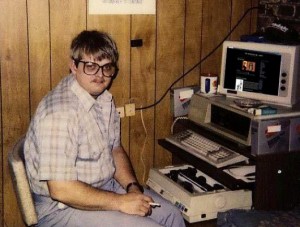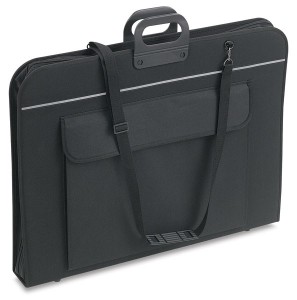I just turned 25, meaning every year after this one can be rounded up to 30. I’m about THIRTY years old… How can this be happening? I remember my golden years in High School as if it were yesterday… Where was I? What have I been doing? Wait, does this mean I have to worry about baby diapers and a midlife crisis soon?
Looking back, I can say I would have changed a few actions in my life. I was young, a tad directionless, and full of questions. So to help the young aspiring graphic artists out there, here are a few points about freelancing.
1. You Need a Portfolio
This is the basic and most important thing. You need to show work that showcases your talents. Nowadays, an online portfolio is a must for a serious freelancer. It’s what most clients or companies prefer over attached JPGs. If you don’t know how to code websites, there are websites that offer templates or site builders for you to display your work. Obviously if you’re a web designer, it’s essential you create your own portfolio and have your own domain.
Depending on the type of job you’re applying for, your portfolio will be displaying different things. What you want to do however, is keep it concise and simple. Your employer or client probably has a lot of resumes and web portfolios to look through. If he/she has to squint or figure out the navigation to see your works and other pages, you can forget the call back. Also remember that this is a portfolio and not a scrap book. You do not put everything you’ve ever done in there. You only put your best works and you shouldn’t have a hundred of those.
Flash is awesome right? I need like a super cool flash intro page with a spinning dog in the background!
No you do not. You need clean pages with a very clean, but stylistic feel. Yes, there are people who just love the crazy intro pages and stuff, but to many people the music and loading in the beginning is a real turn off. Save that kind of design for a piece within the portfolio. If you had to sort through 50 websites and hire someone based on their body of work, at what point would you find intro music and a 30 second loading screen annoying?

Man, I wasted my youth away...
2. Start While You’re Young
When you first start, you’re not going to make a lot. It’s best to start when you’re still with your folks and don’t have to worry about what you’re having for dinner the following night. Or where you’re sleeping.
This is the time to get a feel of how the business works and if you like personally dealing with clients. If you’re not doing it for the money, you can choose which types of projects you’d like to pick up, rather than be forced to do a project in order to pay the bills. It’s also a good time to learn time management and get a grasp of how much your skills are worth. Your youth is your most care free time, so until you have a family and need to support more than yourself, you can do anything you want.
At this point, even if you’re “interning” rather than serving as a freelancer for a company, it’s worth your time. (Just be sure to at least ask for lunch and travel reimbursement!) Building a portfolio is important at this stage, especially if you didn’t go to school for anything creative related.

Not intimidating at all.
3. You will be Exploited
Unfortunately, the reason companies hire freelancers is because they don’t want to pay for a full time worker. The reason for that can range from the fact that they do not feel the need to have someone on board at all times, to because they don’t want to pay for the benefits of a full time employee. Either way, you are a cheaper solution. But you shouldn’t always feel that way. Yes, this is a learning experience and the time to build a portfolio, but by no means should you feel as if you’re doing something more than you’re paid for. Unfortunately a lot of newbie freelancers doom full time freelancers and even full time employees by offering services for way below the market price. Do not make a habit of selling your service for less than it deserves. You doom the rest of our efforts when you do that, in a field that already hires more freelancers than full time employees.
You must realize however, that many creative companies have a high turnover rate and that most of the people working in it aren’t over 40 years old. As a matter of fact, most of the people I work with are under 29. If you intend to go this path, be prepared to do a lot of skipping around companies and have lots of interviews and resume revisions.

I can work while naked!
4. You can Work Online – Right?
There are a few ways freelancers are hired. It depends on what the employer or client is looking for. If it’s a company looking for a freelancer, they plan to create and maintain a long term relationship with you. This would be most desirable if you want something steady. A lot of times these companies want you to work in-house – that is in their offices. You may get a schedule that may or may not change weekly or called in based on their needs.
If you’re getting your job from a single client with personal needs (like a mom that needs a website for her dog), you won’t be working in much of a corporate environment, but instead will have to depend on your relationship with the client.
So until you’ve established yourself as some super popular designer with tons of past clients and projects, you’ll probably be doing little things for more local companies or people – like logo designs, a three paged website, etc. Technically you don’t need to work in their offices or houses for that. You can work in the comfort of your home and work on your own time. The hardest part about working online is finding your clients. This is where selfless advertising and job sites come in. Places like Craigslist are always great for finding projects to do daily, however a lot of people like to meet in person. This can be both dangerous and inconvenient for you.
A lot of clients don’t trust a person to do their job unless they meet you in person first. When meeting a client that isn’t in a company for the first time, always meet in a busy and public area. A coffee shop is a good place. If you have to meet someone in a small private company that doubles as their house, it’s better to have someone know that you’re going in for this interview. You should know by gut feeling as soon as you enter the room whether something is fishy or not.
In terms of inconvenience, there may not be a lot of jobs for you locally. They may be in another city or state. If you are unable to travel for the meeting or the in-house working, you’re going to have trouble freelancing. This is why references are important and having an online portfolio to display your work. Hopefully past clients and your body of work are good enough to seal the deal.

You make my brain hurt so much...
6. Clients are Clueless
If you follow the posts at Clients From Hell, you already know how clueless and irritating some clients can be. If you freelance for companies or people that aren’t creative agencies, you will be handling your own clientele and be your own project manager. You are your own liaison for the client… And that can be ridiculously aggravating.
Thing is, a lot of clients don’t know what they want and don’t know what they’re talking about. A lot of times they want your creative work based on their input. Notice I said creative work, not creative input. They want a website, but they don’t know how it should look, what it should show, how things should be arranged, etc. They want to follow the models of other websites, but better and with more jazz. They also want an ugly widget to display a clock that flashes the date or a picture of their kid somewhere, for some odd reason. You name it, clients have probably suggested it. Constant exposure to this can cause side effects including a drinking habit, the need to punt small animals…
It’s up to you to manage them and tell them what you are and are not capable of doing. Be honest and don’t bite more than you can chew. If there’s a tight deadline, you tell them what you strongly suggest and guide them like children – kicking and screaming. In the end the customer is always right. You will do what you’re asked to do and worse comes to worse, you just never show that project in your portfolio or mention it ever again.

We need you to pay taxes!
6. Taxes and Benefits
If you’re doing small projects for different people, this won’t apply. But if you live in the U.S. and do freelance work for a single company that totals over $500, you have to pay taxes on it.
I remember my first year of doing freelance work I was so proud of writing a check for Uncle Sam during tax season. It made me feel like an adult. My mom was shaking her head and told me to get a real job. The check was for $3,000. And it hadn’t even been a full year. Ouch.
If you happen to be a young adult and no longer under the insurance of your parents and your country does not offer free medical, dental and vision, you need to buy that yourself. At most you need to buy insurance for hospital visits. That’s what I ended up doing for a year. I couldn’t afford dental, vision and medical, so I made sure I could at least be insured for hospital visits. Let’s face it – that’s when you need it the most. Everything else you can pay out of pocket, if you need it badly enough. Except if you need medication. Do you see why your parents tell you to get a good job with benefits?
There are organizations like Freelancers Union where you can get something close to a group insurance rate – but for the most part they’re still nowhere as good as being in a company that offers benefits for a fraction of what you’d have to pay for alone. (A decent full coverage is a few hundred shy of a thousand dollars a month, kids.) So if you plan on freelancing forever, you’d better make enough to cover for that. Unless you’re a risk-taker. I mean who needs health insurance anyway? I never go outside…

Daytime reruns are always fun.
7. The Dry Seasons
If you base your income solely on freelancing, you will find that there will be dry spells. That is, time in which you will not be able to find work. These can last months. (If it’s over a year, it’s time you found a part time job, at least…) Many full time freelancers live off the few months they are busy with work that will be able to support them for the rest of the year. We’re talking about making tens of thousands here. So if you’re not making that much, you’re not going to survive with the luxuries your parents give you. Remember the Spider Man movies and the crappy NYC apartments? Or hear about the closet sized spaces that are rented as apartments? They’re real. People really do live that way, aspiring to become something bigger. Are you depressed or deterred yet? If not then read on.

I think I just pooped a little.
8. It’s About the Freedom
The great thing about freelancing is that you can do it whenever you have free time. People with full time jobs can freelance their hobby on the side. It’s not for the cash. It’s for the possibility of changing fields and doing something you like. And if you do full time freelancing, you’re doing it because you love what you do. You don’t expect to be rich and you live your life in a more care free manner. More power to you. Is it stable? Absolutely not. Is it fun? Hell yes.
So while you’re young, what have you got to lose?





September 25, 2011
Oh, life. Gotta hate you too.
September 23, 2011
You have not lied about the dry spells, I hate them. I’m redoing my portfolio now, It was over do. I’m doing it w/ wordpress.
Clients are forever clueless, can’t put .psd, or .png in a sentence without somebody saying, “huh”?
September 23, 2011
Aim for the full time job. ^__~
It’s not the client’s job to know a lot. It’s just harder for us, that’s all… >__>